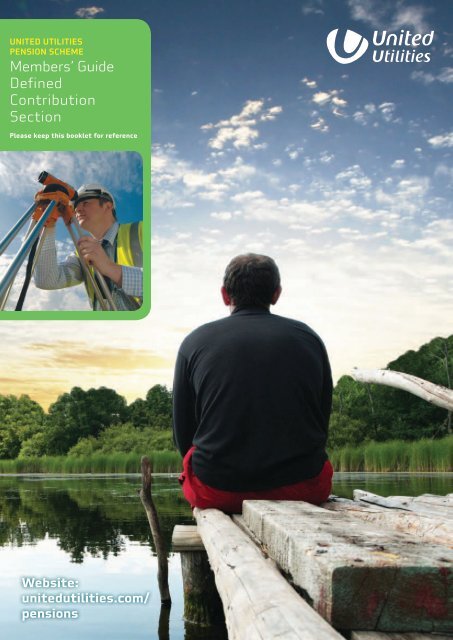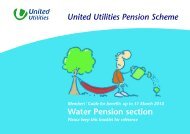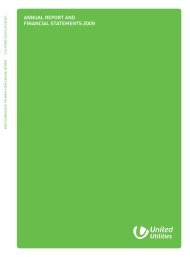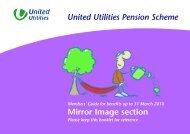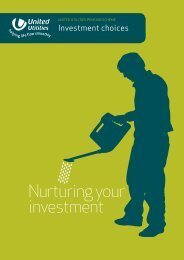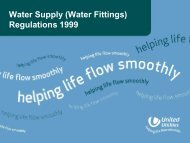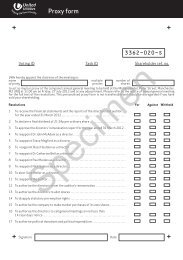UUPS - About United Utilities
UUPS - About United Utilities
UUPS - About United Utilities
Create successful ePaper yourself
Turn your PDF publications into a flip-book with our unique Google optimized e-Paper software.
UNITED UTILITIESPENSION SCHEMEMembers’ GuideDefinedContributionSectionPlease keep this booklet for referenceWebsite:unitedutilities.com/pensions1
Contents3 <strong>About</strong> this Guide4 Your choice in brief5 How the Defined Contribution section of <strong>UUPS</strong> works6 <strong>UUPS</strong> - Defined Contribution section at a glance7 Joining8 Contributions10 Ways to increase your benefits11 Transfers from other schemes12 Investment14 Retirement benefits17 State benefits and your <strong>UUPS</strong> pension18 Benefits payable on death19 Expression of Wish forms20 Leaving <strong>UUPS</strong>21 Pension increases21 Family questions22 Her Majesty’s Revenue and Customs allowances23 General information25 Contacts (useful names and addresses)26 Glossary of terms2
<strong>About</strong> this GuideThis Guide tells you about theDefined Contribution section of the<strong>United</strong> <strong>Utilities</strong> Pension Scheme(<strong>UUPS</strong>) and is intended as an easyreference guide for you.Nothing in the Guide, however, can override the legalposition which is set out in the Trust Deed and Rules,copies of which are available for your inspection onthe <strong>United</strong> <strong>Utilities</strong> website (please see page 25)Some of the words and phrases used have specialmeanings that are set out in the Glossary of Termson page 26. Where these appear in the text they areshown in bold print.The Company and the Trustee are not allowed by theFinancial Services and Markets Act, 2000 to adviseyou whether a particular pension plan is appropriatefor you, or which choice you should make.This Guide is applicable to employees who join theDefined Contribution section of <strong>UUPS</strong> on or after1 July 2003.Revised March 2009Keep this Guide in a safeplace – you or your next ofkin may need to use it.3
Your choice in briefYou have a choice aboutwhether to become amember of <strong>UUPS</strong> and receivea range of benefits for youand your family. You can alsomake your own arrangementsthrough a personal pensionor rely only on pensionprovided by the State,including the AdditionalState Pension. Pleaseconsider the options verycarefully before you makeyour choice, noting thatthe company will NOT paycontributions to a personalpension arrangement. Youmight also wish to consult anauthorised financial adviserfor further guidance.YOUR PENSION CHOICEMembership of <strong>UUPS</strong> is not compulsory.The alternatives to being a member are:to take out a Personal Pension with aninsurance company or other financialbody (note that the Company will notmake any contributions towards aPersonal Pension); and/orto make no further provision forretirement other than continuing topay National Insurance contributionsto the State Pension arrangements.Recent changes in legislation mean thatyou can now pay into more than onepension arrangement at the same time.<strong>UUPS</strong> provides valuable benefits toyou and your family. You should thinkcarefully before making a decision not tojoin, or to opt-out of, <strong>UUPS</strong>.WHY YOU SHOULD BE INTERESTEDIN <strong>UUPS</strong>Because it provides benefits for youand your family when you retire, and inaddition:significant company contributions;protection of the retirement benefitsyou have earned if you leave;a lump sum in the event of your deathprior to retirement;dependants’ benefits depending onthe choices you make at retirement;andmembership also includesmembership of the Group IncomeProtection Scheme.In addition, at retirement you will havethe right to take part of your PersonalAccount as a cash lump sum when youretire.4
How the Defined Contributionsection of <strong>UUPS</strong> worksThe following sectionsummarises how yourpension benefits are built up.More detail is contained inlater sections of this Guide.The Defined Contribution sectionof <strong>UUPS</strong> operates on the definedcontribution (or money purchase)principle. This means that your RegularContributions are invested by theTrustee in your Personal Account.If you make Additional VoluntaryContributions (AVCs) these are investedin the same way.Alternatively, you may ask the Trustee toinvest your Personal Account and AVCsin a ‘Lifestyle’ fund described on page 12.You should then choose the investmentFund or Funds in which you wouldlike your Personal Account and AVCsinvested, and put your choice on the<strong>UUPS</strong> Application Form.At retirement your Personal Account isused to buy a pension for you and yourdependants.The pension you will receive on yourretirement depends on four factors:Regular Contributions paid by youand the Company and AVCs paid byyou;investment growth on those RegularContributions and AVCsthe cost of securing benefits for youand your dependants when you retire;andyour age at retirement.The more contributions paid whileyou are working and the greater theinvestments have grown, the higher yourretirement pension will be.INVESTMENT OPTIONSThe Trustee has made available a choiceof investment Funds in which you caninvest your Personal Account and AVCs.Each Fund has different objectives,characteristics and charges. The riskprofile and investment return achievedon each Fund is therefore likely to bequite different. The investment optionsare described in the Investment sectionon page 12 and the separate ‘InvestmentChoices’ leaflet. Please read thesecarefully.It is for you to choose how your PersonalAccount and AVCs are invested betweeneach Fund. We hope the Investmentsection, the separate ‘InvestmentChoices’ leaflet and additionalinformation on the pension website (e.g.investment performance) give you all theinformation you need to make a choice.However, if you need further help youshould contact an Independent FinancialAdviser. The Trustee is not authorised togive you any investment advice.You should note that the Trustee willnot be liable for any loss arising fromyour investment choices (including the‘Lifestyle’ option).Your investment options should bereviewed by you on a regular basis. Youmay change your investment options andthe way in which your Personal Accountand AVCs are invested from time to time.At present, there will be no charge fordoing this. Further details are given inthe ‘Investment’ section on page 12.The Trustee will regularly monitor theperformance of the investment fundsoffered to members and reserves theright to change investment managers, orthe funds made available to members,at any time. You will be told if yourinvestments are affected by any changes.5
<strong>UUPS</strong> - Defined Contribution sectionat a glanceThe following list showsthe main benefits andprovisions of the DefinedContribution section of<strong>UUPS</strong>. You will find a fullerexplanation later in thesections of this Guide.MINIMUM AGE OF ENTRY16CONTRIBUTIONS (PAGE 8)The Company policy is to automaticallyopt new employees in to <strong>UUPS</strong>. Onjoining, you will automatically pay 5%of your Pensionable Earnings, withthe option to increase to 6% or 7%, ordecrease to 3% or 4%, of PensionableEarnings. The Company pays doubleyour contributions. You can also payAdditional Voluntary Contributions(AVCs).INVESTMENT (PAGE 12)A choice of several investment funds,with the option to switch betweenfunds. The investment section of thisbooklet and ‘Investment Choices’ leafletare available to help you to make achoice. You can switch between fundson the first day of any month. If youdo not make a choice on joining, yourcontributions will be automaticallyinvested in the Lifestyle OptionDEATH IN SERVICE (PAGE 18)Lump sum of 2 times your PensionableEarnings, with the option to increase thisamount, plus a refund of your PersonalAccount and the value of your AVCs. Ifyou decide not to join <strong>UUPS</strong> (or opt out),you will still be provided with a lumpsum of 2 times Pensionable Earnings ondeath in service, but with no option toincrease this amount.GROUP INCOME PROTECTION (PAGE 15)In the event of long term sickness youmay qualify for payments under theseparate Group Income ProtectionScheme (GIP) operated by the Company.RETIREMENT BENEFITS (PAGE 14)a pension provided by your PersonalAccount and your AVCs for you and, ifyou choose, for your dependants; anda lump sum instead of part of yourpension.VOLUNTARY RETIREMENT (PAGE 15)Payment of an immediate pension -currently from age 50 (note: this willincrease to age 55 from 2010 in line withrecent legislation).DEATH AFTER RETIREMENT (PAGE 14)Dependants’ benefits depending on thechoices you made at retirement.PENSION INCREASES (PAGE 21)When you buy a pension at retirementyou will have the option to choosewhether to have your pension increasingor not during payment. The higher theincreases chosen the lower the initialpension.6
JoiningMembership of the DefinedContribution section of<strong>UUPS</strong> is available to allemployees of the Companywho meet the conditionsshown below.WHO CAN JOIN <strong>UUPS</strong>?Employees can join the DefinedContribution section of <strong>UUPS</strong> if they areinvited by their Employer and are aged16 but have not attained age 65.WHEN YOU MAY JOINIf you satisfy the joining conditionsdescribed above you will automaticallybecome a member on joining theCompany.You must complete an application formindicating the level of contributionsyou wish to make and an investmentallocation form indicating where yourcontributions, and those made by theCompany, are to be invested.OPT OUTYou can opt out of <strong>UUPS</strong> at any time bygiving 60 days’ notice in writing to theTrustee. Whilst you remain in servicewith the Company there will still be alump sum of 2 times your PensionableEarnings payable on death in service. Ifyou decide to opt out of the Scheme youwill not be eligible to apply for GroupIncome Protection. For information onGroup Income Protection please seepage 16.JOINING OR REJOINING <strong>UUPS</strong> AT ALATER DATEYou can only join or rejoin at a later dateif the Company agrees. Admittance maybe subject to the production of medicalinformation, and special conditions maybe imposed.In the event that you do not completethese forms on joining, contributionswill be deducted at the rate of 5% ofPensionable Earnings and invested inthe Lifestyle Option. It is importantfor you to review both the level ofcontribution you pay and the typeof investment fund into which yourPersonal Account is invested when youjoin <strong>UUPS</strong> and at regular intervals duringyour membership. You must completean application form if you wish to changeany of the defaulted details.7
MEMBERS ON MATERNITY LEAVEWhile you are on paid maternity leave:you continue to pay your RegularContributions, but based on the pay(including statutory maternity pay)you are actually paid; andthe Company’s Regular Contributionsin respect of you are based on thePensionable Earnings you wouldhave received had you been workingnormally.While you are on unpaid maternity leave,you and the Company are not required topay contributions.Your lump sum death benefit cover willcontinue (see page 18) while you are onmaternity leave, whether paid or unpaid.OTHER PERIODS OF ABSENCEIf you are absent from work for any otherreason on reduced or no pay, you will beinformed by the Company as to how thisaffects your lump sum death benefitsand contributions for the period ofabsence.For further information on temporaryabsence due to illness or injury pleasesee the Group Income ProtectionScheme section on page 16.EMPLOYER’S SALARY SACRIFICEARRANGEMENTAs a member you will have the optionto participate in the Company’s SalarySacrifice arrangement which is knownas PensionSaver. If you participatein PensionSaver, you will not pay anypension contributions yourself. Instead,the Company will pay contributions foryou to <strong>UUPS</strong> (in addition to the normalCompany contributions) at the same rateas the Regular Contributions you wouldhave otherwise paid and reduce your payby the same amount. Because your pay islower, this will result in your paying lessin National Insurance contributions andtherefore increasing your net pay.For further information on howPensionSaver works and why you maywish to participate, please refer tothe PensionSaver booklet issued bythe Company. A copy of the guide toPensionSaver is available from the<strong>United</strong> <strong>Utilities</strong> website (please seepage 25).9
Ways to increase your benefitsYou have the option topay Additional VoluntaryContributions (AVCs) whichcan be used to increaseyour pension benefits.Contributions to recognisedAVC arrangements currentlyreceive tax relief.Members can pay Additional VoluntaryContributions (AVCs), which also attracttax relief.Any AVCs that you pay, or have paid,in excess of the 7% of PensionableEarnings limit will not attract additionalcontributions from the Company.Alternatively, you can pay ‘Free StandingAdditional Voluntary Contributions’(FSAVCs) to some insurance companiesand other financial organisations.(NOTE: If you set up FSAVCs, neither theCompany nor <strong>UUPS</strong> will be involved butyou will still be entitled to tax relief.)You have the same investment choice foryour AVCs as you have for your RegularContributions (see the Investmentsection on page 12 and the separate‘Investment Choices’ leaflet).Further information about the AVCarrangements is available from the<strong>United</strong> <strong>Utilities</strong> website or the SchemeAdministrator (see page 25).AVCs and FSAVCs may be used to:increase your own retirement pension,and your lump sum; andincrease your spouse’s anddependants’ benefits.Please note that the HMRC haveimposed a limit on the amount ofpension savings which can receive taxrelief. This is known as the AnnualAllowance. For the current amountof the Annual Allowance please referto the pension website:www.unitedutilities.com/pensionsFor some members, the scope for taxeffective additional pension provisionmay be restricted by the allowancesrecently introduced by HMRC (seepage 22 for further details on HMRCallowances).10
Transfers from other schemesIf you have built up benefitsin another pension scheme,you may have the option totransfer the value of thosebenefits into your PersonalAccount in <strong>UUPS</strong>.The Trustee may, with the consentof the Company, accept a transferpayment from another pension scheme(but certain pension benefits knownas contracted-out/Protected Rightscannot be accepted). Pension rightsin a previous employer’s scheme or apersonal pension plan transferred to<strong>UUPS</strong> will be added to your PersonalAccount and the value of any AVCs paidduring your membership of your previousscheme will automatically be transferredand added to your AVC fund.There are no charges or penaltiesfor transferring benefits levied bythe Scheme.You can choose how any moneytransferred into your Personal Accountis invested (see the ‘Investment’ sectionon page 12 and the separate ‘InvestmentChoices’ leaflet).If you are interested in a transfer pleasecontact the Scheme Administrator (seepage 25).11
InvestmentYou have a number of choicesas to how your contributions(including AVCs), and thosemade by the Company, areinvested.WHY YOUR CONTRIBUTIONS NEED TOBE INVESTEDRegular Contributions and AVCs areused to provide you and your dependantswith pension benefits in the future.Generally, this will be when you retirefrom work. By that time you want yourPersonal Account and AVCs to havegrown as big as possible to maximiseyour pension benefits.Therefore you want your RegularContributions and AVCs to be investedso as to achieve the best possible rate ofreturn without taking undue risk. Thereare many different types of investmentavailable, company shares (or equities),bonds issued by governments orcompanies, property, various types ofcash deposit. There are many differenttypes of funds offered by investmentproviders with some attempting to‘smooth’ the impact of fluctuatingmarket returns.Some types of investments generallyprovide higher returns than others overa reasonable period of years. However,those which look most likely to providethe highest returns in the long term arealso the ones with the most variablereturns and where the value of theinvestments is most likely to fluctuate.Remember that the value of manyinvestments can move down as well asup; the values of overseas investmentsalso vary with fluctuations in exchangerates.INVESTMENT FUNDS AVAILABLEThe investment funds available relateto shares, bonds, property, cash or acombination of these.The Trustee has divided the fundsavailable into ‘Core Funds’ and ‘Non-CoreFunds’. Core Funds are expected tomeet the needs of the majority of <strong>UUPS</strong>’members whilst Non-Core Funds arefor members who want to invest moreactively and feel comfortable selectingfrom a wider variety of investmentoptions.Please refer to the separate ‘InvestmentChoices’ leaflet for guidance on eachinvestment type and details of the CoreFunds and Non-Core Funds.CHOOSING YOUR INVESTMENT FUNDYou can choose to invest in any or all ofthe available Funds. Please refer to theseparate ‘Investment Choices’ leaflet fordetails of the Funds currently availableand issues to consider when making yourinvestment choices.THE LIFESTYLE OPTIONThere can be no guarantee that anyparticular strategy will result in thebiggest possible Personal Accountand AVCs over your membership of<strong>UUPS</strong>. However the Trustee provides aLifestyle Option which aims to maximisereturn by investing in shares via anequity fund, until five years before youranticipated date of retirement, and thenprogressively switches over that fiveyear period, from the equity fund to anindex-linked bond fund and deposit fund.Please note that the Lifestyle Optionis the default if you do not make aninvestment selection when you firstjoin <strong>UUPS</strong>.The Scheme’s Normal Retirement Dateis 65, which means - if you select theLifestyle Option for your contributions- the switching periods detailed belowwill start when you reach age 60. If yourplans change and/or you would like toretire before age 65, you may requestthat the switching periods begin earlierto ensure that it is completed by thetime you retire.If you are considering early retirementyou should contact the SchemeAdministrator (see page 25) to changeyour selected retirement age. This willbe done on a confidential basis. Yourinvestments will then be adjusted sothat the end of the switching period cancoincide with your retirement.Note: this Lifestyle Fund will notnecessarily be appropriate forunexpected events such as death orearlier than anticipated retirement.It may also not be appropriate for allindividuals who have different personaland financial circumstances. You arestrongly encouraged to consider yourown circumstances when making yourinvestment decision.For further details, please see the‘Investment Choices’ leaflet (available atwww.unitedutilities.com/pensions).YOUR CHOICEYou can choose any of the availableFunds – or any combination of the Fundsin whatever proportions you decide – atany stage of your membership of <strong>UUPS</strong>for both your Personal Account andAVCs. You can switch Funds on the 1stof any month. For further details pleasesee the separate ‘Investment Choices’leaflet.12
If you do decide to change the Fund forfuture contributions, you may leave theunits which you have already bought intheir existing Funds, or switch them toone of the other Funds.WHERE TO FIND INFORMATION ONPERFORMANCE OF THE INVESTMENTFUNDS CHOSEN.Winterthur Life have a website www.winterthur-life.co.uk which providesdetails of each fund including details ofperformance as guidance. The Trusteealso issues periodic updates.INVESTMENT CHARGESA charge is made from your PersonalAccount and the value of your AVCs tocover investment charges. The chargeis made within the Fund and is reflectedin the price of Fund units. For details ofthe charges please refer to the separate‘Investment Choices’ leaflet or contactWinterthur Life.CHANGE OF MANAGER OR FUNDSThe Trustee has selected the currentrange of Funds with the help ofindependent specialist advisers andexpects to retain them for many years.However the Trustee will monitorperformance and may replace the fundsavailable to members, or introducenew funds, if it believes that it is in themembers’ best interests. If that were tohappen, the Trustee reserves the right totransfer individuals’ Personal Accountsand AVCs, if invested in funds which areno longer available, to whichever of theavailable funds the Trustee considersmost appropriate. Members wouldbe notified and contributing membersadvised of the alternative investmentoptions then available to them.13
Retirement benefitsThe following sectionexplains the choicesavailable to you atretirement, and when yourbenefits can be paid.AMOUNT OF BENEFITSAt your Normal Retirement Date (NRD),you are entitled to receive pensionbenefits based upon the value of yourPersonal Account and AVCs. The amountof your pension benefit depends on yourage and the cost of buying pensions atthe time.EARLY RETIREMENT IN NORMALHEALTHCurrently, if you leave service, have atleast 2 years’ Qualifying Service andare aged 50 or more, you can take yourbenefits immediately.However, from 6 April 2010, the earliestage at which you will be able to draw yourpension will be increased from age 50to 55 by law, except in certain limitedcircumstances.WHAT HAPPENS AT RETIREMENT?When you retire the value of yourPersonal Account and AVCs will be usedto buy benefits for you with an insurancecompany. Alternatively you have theright to an ‘open market option’ andtell the Trustee what type of benefitsyou require from an insurance companyselected by you. If you wish to effectthis latter option, you need to contactthe Trustee two months before youexpect to retire. Any costs associatedwith the ‘open market option’ will be metout of your Personal Account.Whichever way your pension is secured,you will have options about the preciseform of your benefits:a pension for yourself;you will be able to take part of yourFund as a tax free cash sum;dependants’ pensions; andpension increases.14
The actual options you choose will affectthe initial amount of your pension. YourAVCs may also be used to provide anyone or more of these benefits.The cost of buying a pension for youwill also depend on your age andeconomic circumstances when you retire.Generally the younger you are when youretire, then the lower your pension willbe as it is expected to be paid for longer.Effectively, the cost of buying a pensionis more when you are younger than whenyou are older.The cost of buying a pension changesfrequently in line with changes toeconomic conditions and, in particular,changes in long term interest rates.The value of your total retirementbenefits (from <strong>UUPS</strong> and any otherpension scheme or pension arrangement,excluding benefits paid by the State)will be checked against the LifetimeAllowance (LTA). Any benefits built upabove the LTA will be subject to a higheroverall tax charge when they are drawn.(See page 22 for further details.)You will be able to take up to 25% ofyour total fund value (or 25% of theLifetime Allowance (LTA), if lower) as atax-free cash sum.LONG TERM SICKNESSIn the event of long term sickness youmay qualify for payments under theseparate Group Income ProtectionScheme (GIP) operated by the Company.For details please refer to page 16.If you do qualify for payments under theGIP you will remain a member of <strong>UUPS</strong>and your Regular Contributions andthose of the Company will continue tobe paid into <strong>UUPS</strong> from the GIP. Thesecontributions will increase each year onthe anniversary of the commencementof benefit payments under the GIP, bythe lesser of 5% and the increase in theRetail Prices Index.Contributions paid by the GIP into <strong>UUPS</strong>will cease on your return to work, on yourretirement, on reaching age 70, on yourdeath or on your leaving the Company.AVC BENEFITSWhenever you retire, you are entitledto receive the benefits secured by yourAVCs in addition to the benefits securedby your Personal Account. You may takeup to 25% of your AVC funds as cash.The remainder would be used to buy apension.FLEXIBLE RETIREMENTWorking beyond age 65You have the right to request to continueworking after the Company retirementage of 65. If you work past the Companyretirement age of 65 you can continueto contribute to <strong>UUPS</strong> in line with thescheme rules. Please note howeverthat, in line with pension legislation, itis not possible for someone to makecontributions into a pension schemeafter the age of 75 and, even if youcontinue to be employed after age 75,you will need to start receiving yourpension benefits at that time.Alternatively, once you have passedNRD, you can request to receive yourpension whilst working at any time.Receiving a pension whilst workingThe Company will consider requestsif you wish to receive a pension whilstworking prior to your NRD.You will need to write to your managerdetailing your request including whetheryou wish to combine it with a change inworking pattern and it will be consideredin line with business needs.If it is agreed by the Company that youcan receive a pension whilst working, youcan continue to make contributions to<strong>UUPS</strong> if you wish.If you are interested in applying to takeyour pension whilst still working youshould carefully consider all the financialimplication and we strongly advise thatyou seek independent financial advicebefore making any final decisions.Things to remember when consideringretirementThere are a number of factors you shouldalso take into consideration when youare approaching retirement or thinkingabout retiring early.Once in payment, your pension will bepayable for life.The total pension benefits payablewhen you retire will be checkedagainst the LTA (see page 22) for taxpurposes.If you retire early (rather than atNRD), your Personal Account will havereceived fewer Regular Contributions(and you may have made fewer AVCs),and it will have had less opportunityto grow by investment. The benefitsyou receive can only reflect the valueof your Personal Account and AVCs,and the cost of buying a pension atthe time you retire.You may provide a pension for anydependant or for your spouse. Theterms of this dependant’s pensiondepend on the choices you makeat the time it is bought from theinsurance company.Pension increasesAll pensions, including your own andany dependant’s, are taxed as earnedincome on a ‘Pay As You Earn’ basis. 15
GROUP INCOME PROTECTION SCHEME(GIP SCHEME)As a member of the Defined Contributionsection of <strong>UUPS</strong> you will automaticallybe covered by the GIP Scheme whichis designed to ensure that you receivea proportion of your salary if you areabsent for a prolonged period due toillness or injury.This section summarises the GIPScheme, the full cost of which is borne bythe Company and is deducted from theCompany contributions paid into <strong>UUPS</strong>on your behalf (please see page 8 formore detail). You therefore incur no taxliability for the cost of the GIP benefit.The GIP Scheme is currently insured withCanada Life which is a leading insurancecompany. Benefit payment will bedependant on any conditions imposed byand the requirements of Canada Life.Income BenefitIf you are away from work and satisfythe GIP Scheme criteria, then onceyou have been absent for a continuousperiod of 52 weeks, the GIP schemewill pay a benefit equal to 50% of yourPensionable Earnings applicable prior toyou becoming absent.In order to qualify for benefit, youmust be unable, by reason of sicknessor accident, to follow the materialand substantial duties of your ownoccupation and not be engaged in anyother occupation.A stricter definition of Incapacity will beimposed for certain licensed occupationsand occupations requiring specialistskills or high levels of fitness.The GIP Scheme pays the Company andthe Scheme Administrator. The Companycontinues to pay the employee via payroll.Pension and Life Assurance benefitThe GIP Scheme will also pay an amountto the Company to cover your own andthe Company’s contributions to <strong>UUPS</strong>in order that your pension and lifeassurance benefits are protected.National Insurance BenefitThe GIP Scheme will also pay a benefitto the Company to cover the Company’sNational Insurance contributions whilstyou are absent.Payment of BenefitBenefit will be paid to you, via theCompany’s payroll. On the anniversaryof the commencement of your benefit,and yearly thereafter, your benefit willincrease by the lesser of 5% and theincrease in the Retail Prices Index.Should you return to work and becomeabsent for the same reason within aperiod of 26 weeks, your GIP benefitpayment will resume immediately.Benefit will cease on your return to work,on your retirement, on you reaching age65, on your death or on you leaving theCompany.Partial DisabilityA proportionate benefit may be payablein the event of your returning to workon a part-time basis or to a lower paidoccupation with the Company. Medicalevidence and Company consent may berequired.Medical EvidenceBenefit payment will be dependenton the insurance company receivingsatisfactory medical evidence to supportthe claim made on your behalf andagreeing to pay the benefit. From timeto time during the course of a claim,the insurance company will review theevidence to make sure the claim remainslegitimate.If you join the <strong>UUPS</strong> after the date youare first eligible, the insurer may requiresatisfactory medical evidence beforeconfirming cover under the GIP Scheme.Leaving the CompanyShould you leave the Company withouta claim being in payment, you may havethe option to continue the policy, on anindividual basis with the insurer, withoutthe need to provide medical evidence.This must be effected within 30 days ofyou leaving employment.Termination or AmendmentAlthough the Company intends tomaintain the GIP Scheme in the future,it reserves the right to terminate theGIP Scheme or to amend the basis at anytime. You would be given appropriatenotice of this occurrence.16
State benefits and your <strong>UUPS</strong>pensionThe current State pensionarrangements are in twoparts: the Basic StatePension which almosteveryone receives atState Pension Age and theAdditional State Pension.The Defined Contributionsection of <strong>UUPS</strong> is notcontracted-out of theAdditional State Pensionwhich means you will earnadditional State benefitsin addition to your <strong>UUPS</strong>benefits, whilst you arean active member of theDefined Contribution sectionof <strong>UUPS</strong>.HOW THE STATE PENSION IS MADE UPThe current State pension arrangementsare in two parts:BASIC STATE PENSIONThis is payable to almost everyone.The amount is set by the Governmenteach year but if there is a gap in yourNational Insurance contribution recordyou may not receive the full amount(contact the Department for Work andPensions if you wish to check, see page25). Women who have always paid themarried woman’s reduced rate NationalInsurance contributions will not receivethis pension. Your Basic State Pension isnot affected by your <strong>UUPS</strong> pension.ADDITIONAL STATE PENSIONThis is a pension, based partly onearnings, that is provided in additionto the Basic State Pension. The StateSecond Pension (S2P) replaced theState Earnings Related Pension Scheme(SERPS) from 6 April 2002.The Additional State Pension willbe paid from State Pension Age inrespect of employment during whichyou are not contracted-out of the Statearrangements including the periodduring which you are a member of theDefined Contribution section of <strong>UUPS</strong>.This is because the Defined Contributionsection of <strong>UUPS</strong> currently is notcontracted-out of S2P and means thatfull rate National Insurance contributionsare deducted from your pay whilst youare paying contributions into <strong>UUPS</strong>.You can elect to contract-out of S2Pon an individual basis. If you wish toconsider this option, you should seekadvice from an Independent FinancialAdviser.17
Benefits payable on deathWhether you die after youretire or whilst still workingfor the Company, <strong>UUPS</strong> canprovide a range of benefitsfor your spouse, children anddependants.These include pensions and,in some circumstances, cashlump sums. Details of thebenefits payable are shownin the following sections.DEATH IN SERVICEHow your family is protectedThere will be a lump sum payment foryour beneficiaries.How the lump sum is calculatedThe lump sum will be:2 x Pensionable Earnings; plusyour Personal Account and the valueof your AVCs.Under current tax rules, the lump sumpayment will normally be free of tax.If you choose not to join <strong>UUPS</strong> or optout,you will still be provided with a lumpsum of 2 x Pensionable Earnings ondeath in service.ADDITIONAL LIFE COVERYou have the option to increase thelump sum up to a maximum of 12 xPensionable Earnings. However, onlylump sum benefits up to the level of theLTA (see page 22) can be paid tax-free.You will be able to choose additionalmultiples of earnings:a) on joining <strong>UUPS</strong>; orb) once a year at a lifestyle event(primarily marriage or the birth ofa child) you will be able to increasecover by 1 x Pensionable Earningsproviding you satisfy the insurancecompany’s “at work” criteria; andc) at the renewal date, 1 July each year,you will be able to increase coverby up to 1 x Pensionable Earningssubject to satisfying the “at work”criteria. The “at work” criteria isthat you are at work on the date ofincrease and have not been absentdue to illness or disablement formore than 15 days in the previous12 months.You may be able to increase cover atother times, or by additional multiplesof Pensionable Earnings, subject to theproduction of any satisfactory medicalevidence the insurance company mayrequire.Please refer to page 8 ‘Deductions fromRegular Contributions’ for details of thecost of providing the basic level of lifecover and to the additional life coverleaflets for the cost of increasing thelevel of your cover. If you wish to receivedetails about how much it will cost you toincrease your life cover please contactyour payroll department.WHO RECEIVES THE LUMP SUM?The Trustee decides who should receivethe lump sum but it will take intoaccount your wishes as indicated onyour Expression of Wish form and yourpersonal circumstances at the time ofyour death. More information is given onpage 19.MEDICAL EVIDENCEIf you join <strong>UUPS</strong> after your firstopportunity you are a late entrant andthe insurance company may requiresatisfactory medical evidence prior tocovering you for any lump sum abovethe standard 2 x Pensionable Earningsbenefit.DEATH AFTER RETIREMENTHow your family is protected on yourdeath depends on the choices you madeat your retirement (see ‘RetirementBenefits’ on pages 14 to 15).The cost of the lump sum of 2 xPensionable Earnings is met by adeduction from the Company’s RegularContributions.The cost of providing this additionalcover is met by a deduction from yourRegular Contributions and is dependenton your age and the amount of additionalcover you require.18
Expression of Wish formsIt is very important that youcomplete an Expression ofWish form to let the Trusteeknow to whom you wouldprefer any lump sum benefitto be paid, in the event ofyour death.It is your responsibility to complete andreturn an Expression of Wish form andkeep it up to date. When completed,your Expression of Wish form should beforwarded to the Pensions departmentfor safekeeping (see page 25). This willensure the security of the informationprovided and guarantee that it isimmediately available to the Trustee.If you wish to change the informationin the future, blank Expression ofWish forms are available from your HRdepartment or from the pension sectionof the Company’s internet site (seepage 25).19
Leaving <strong>UUPS</strong>If you leave <strong>UUPS</strong>, forinstance as a result ofleaving the Company, yourPersonal Account and AVCswill still be available toprovide benefits for you. Thebenefits available to youdepend on your length ofservice at the time you leave.UNDER 3 MONTHS’ QUALIFYINGSERVICE20A refund of that part of your PersonalAccount which represents yourRegular Contributions and any AVCs,less tax (currently at the rate of 20%).If you are in PensionSaver you willreceive an ex-gratia payment fromthe Company equal to the reductionin salary due to PensionSaver. Anyex-gratia payments will be subject toincome tax and National Insurance atthe normal rate that you pay.BETWEEN 3 MONTHS’ AND 2 YEARS’QUALIFYING SERVICEA refund of that part of your PersonalAccount which represents yourRegular Contributions and any AVCs,less tax (currently at the rate of 20%).If you are in PensionSaver you willreceive an ex-gratia payment fromthe Company equal to the reductionin salary due to PensionSaver. Anyex-gratia payment will be subject toincome tax and National Insurance atthe normal rate that you pay, orTransfer of your Personal Accountand any AVCs to another registeredpension scheme or personal planor a buy-out annuity policy from aninsurance company.MORE THAN 2 YEARS’ QUALIFYINGSERVICEYour Personal Account and anyAVCs remain in <strong>UUPS</strong>. No morecontributions are paid into them, butthey remain invested until you retire,die, or transfer them out of <strong>UUPS</strong>, orTransfer of your Personal Accountand any AVCs to another registeredpension scheme or personal planor a buy-out annuity policy from aninsurance company, orImmediate retirement benefits if youare over age 50 (note, this will changeto age 55 from 6 April 2010).If your Personal Account and any AVCsremain in <strong>UUPS</strong> you will have the samerights to switch your investments inthe period up to retirement had youremained with Company.On your retirement, the value of yourPersonal Account and AVCs are availableto you to choose the appropriatebenefits described under ‘RetirementBenefits’ on pages 14 to 15.You will no longer be covered for thelump sum death benefit normally payableon death before retirement.WHAT HAPPENS TO YOUR PERSONALACCOUNT AND AVCS IF YOU DIE?If you leave <strong>UUPS</strong> but keep your PersonalAccount and your AVCs in <strong>UUPS</strong>, theywill be paid as a lump sum for yourwidow, widower, or dependants (see ‘Whoreceives the lump sum?’ on page 18).After you have left the Company, it isimportant that you keep the Trusteeinformed of all changes in your maritalstatus and home address and that yourExpression of Wish form (see page 19) iskept up to date.TRANSFER OF BENEFITSIf you leave <strong>UUPS</strong> before your NRD,instead of leaving your PersonalAccount and AVCs in <strong>UUPS</strong>, you maybe able to transfer their value to yournew employer’s scheme or an individualpension arrangement. If you wish toconsider this option you should seekadvise from an Independent FinancialAdviser.To investigate this option, you shouldwrite to the Scheme Administrator(see page 25) to ask for a statementof your “transfer value”. They willquote the transfer value available andgive instructions on how to go aboutexercising this option. The transfer valueis usually the value of your PersonalAccount and AVCs.Requests for transfer values can bemade after ceasing employment withthe Company or opting out of <strong>UUPS</strong>.The Trustee is not obliged to give youanother statement within 12 monthsof your last request without making acharge.If the estimate of the transfer valueis needed because of a divorcesettlement, you should tell the SchemeAdministrator this when asking for theestimate as the Scheme Administratormay need further information from you.
PensionincreasesFamilyquestionsAt retirement you have achoice of whether to have afixed pension or a pensionwhich increases each year.If you select a pension thatdoes not increase, you willgenerally receive a higherincome than from an annuitythat does increase. However,as time goes by, the realvalue of your income willbe eroded by the effects ofinflation (goods cost moreyet your income remains atthe same level).Changes in your maritalcircumstances can affectthe benefits payable to yourspouse, or dependants.IF YOU DIVORCEIf you divorce, your former spouse maybecome entitled to part of your pension(or its equivalent value) as part of yourdivorce settlement. Contact the SchemeAdministrator for further details (seepage 25).You can select the level you want yourincome to increase by each year forexample, 3%, 5%, Retail Prices Index(RPI) or Limited Price Indexation (LPI).Increasing your income by the RPI, meansit increases in line with inflation so yourincome will retain its buying power.Increasing by LPI, means the income willincrease in line with inflation but up to amaximum of 5% each year.21
Her Majesty’s Revenue and CustomsAllowancesThe Government introducednew ‘simplification’ pensionlegislation with effect from6 April 2006 (A-Day). Twokey measures underpinthe legislation. These arethe introduction of a newhigher limit on the amountof contributions thatyou can make to pensionarrangements tax-efficientlyeach year (the ‘AnnualAllowance’) and a new limiton the total value of pensionbenefits that you can buildup tax-efficiently (the‘Lifetime Allowance’ (LTA)).ANNUAL ALLOWANCEPlease note that the HMRC haveimposed a limit on the amount of pensionsavings which can receive tax relief.This is known as the Annual Allowance.For the current amount of the AnnualAllowance please refer to the pensionwebsite: www.unitedutilities.com/pensionsLIFETIME ALLOWANCEThe value of your retirement fund hasto be checked against the LTA, currentlyset as £1.75 million for the 2009/2010tax year but will not increase between2011 and 2016. This will rise in steps,as announced by the Government, to£1.8 million by 2010/2011 but will notincrease between 2011 and 2016. Youwill be able to build up benefits abovethe LTA but these will be subject to anoverall tax charge of 55% when they aredrawn.You will have the freedom to build upbenefits to the value of the LTA in <strong>UUPS</strong>and/or other private pension schemeswithout having to pay extra tax. StatePension benefits are excluded from theLTA check.WHAT SHOULD I DO?Consider your own pension situationand how the limits might affect yourretirement saving plans.Make sure that you have a clearpicture of all your pension benefits,including any benefits you havebuilt up in your other pensionarrangements.If you have any questions, you maywish to contact an IndependentFinancial Adviser.For further information on the newpensions legislation, please refer tothe March 2006 ‘Pensions Insight,Simplification, security and choice’newsletter, a copy of which can beobtained from the Pensions departmentor the pensions website (see page 25).22
General informationThis section includesinformation on the legalbasis of <strong>UUPS</strong> together withdetails of who to contact ifyou have a query.WHO TO CONTACT IF YOU NEEDFURTHER INFORMATION, HELP ORADVICEAll initial enquiries or requests forfurther information about <strong>UUPS</strong> shouldbe made to the Scheme Administrator(see page 25). All enquiries are dealtwith in strict confidence.LEGAL BACKGROUND<strong>UUPS</strong> is fully tax exempt approved bythe Inland Revenue under Chapter 1, PartXIV of the Income and Corporation TaxesAct 1988. This means <strong>UUPS</strong> and you, asa member, qualify for some tax relief.CONSTITUTION OF <strong>UUPS</strong>The Trustee of <strong>UUPS</strong> is <strong>United</strong> <strong>Utilities</strong>Pensions Trustee Limited. The Boardof Directors of the Trustee Companyincludes representatives from theCompany, <strong>UUPS</strong> membership and anindependent Director.The Trustee is bound by its legal dutyto protect your interests as a <strong>UUPS</strong>member. The benefits and operation of<strong>UUPS</strong>, together with the Trustee’s dutiesand powers, are laid down in a legaldocument known as the Trust Deed andRules which is available on the pensionswebsite (see page 25).ANNUAL REPORTThe Trustee publishes a full AnnualReport that is available on request fromthe Pensions department (see page 25).An abbreviated version of the Report isautomatically issued to members.BENEFIT STATEMENTYou will receive a statement each yearshowing the value of your PersonalAccount and AVCs.PROVISION OF BENEFITS, CHANGESAND TERMINATIONYour own contributions to <strong>UUPS</strong>together with the Company’scontribution are invested in a Trust Fundwhich is held completely separate fromthe assets of the Company and youremployer. All <strong>UUPS</strong> benefits are paidfrom the Trust Fund, which is subject toan independent annual audit.The Company and the Trustee can agreeto change or amend any part of <strong>UUPS</strong>.The Company fully intends to continuethe operation of <strong>UUPS</strong> but it reservesthe right to reduce, suspend or terminatecontributions. In this event, themembers will be informed and the TrustFund would be used in accordance withthe <strong>UUPS</strong> Trust Deed and Rules coveringsuch circumstances.PERSONAL INFORMATIONUnder the Data Protection Act 1998,the Trustee and the Company are “datacontrollers” in relation to data personalto you and which identifies you suchas your name, address and NationalInsurance number (your “personal data”).Some of your personal data may besensitive (such as details of your healthand personal relationships). The Trusteeand the Company have a legitimateinterest in processing your sensitive andnon-sensitive personal data – and thatof other members and beneficiaries of<strong>UUPS</strong> – for purposes associated with<strong>UUPS</strong>. In doing so, they may also usecarefully selected advisers and thirdparties who may be necessary for theadministration of <strong>UUPS</strong>.As a member of <strong>UUPS</strong>, you consent tothe Trustee processing your personaldata for any purposes associated with<strong>UUPS</strong>. You should note that this mayinvolve transferring personal data aboutyou and others to, among others, youremployer, the Company (or any businessassociated with it) or third parties whoassist the Trustee.You should keep the Trustee up to datewith your personal details, including yourmarital status and address, otherwisedelays may occur in paying benefits toyou or your dependants.ASSIGNMENTYou may not assign, charge or use yourbenefits as the security for a loan. Thismeans that you cannot promise to payyour benefits over to someone else assecurity if you take out a loan.WHAT TO DO IF YOU ARE UNHAPPYWITH A DECISION ABOUT YOURPENSION RIGHTSIf you are dissatisfied with anythingto do with <strong>UUPS</strong>, you should, in thefirst instance, write to the SchemeAdministrator who will attempt toresolve your query. If you remaindissatisfied, you may then write to thePensions Manager, (see page 25), whowill provide you with details of <strong>UUPS</strong>’Internal Dispute Resolution Procedure.This is a two-stage process with theaim of resolving any query or complaintyou may have about <strong>UUPS</strong> or yourpension rights. Under the first stage,the Pensions Manager will deal withyour complaint. If you are not satisfiedwith his decision, you may appeal to theTrustee under the second stage.23
OTHER PENSION BODIESA number of other pension bodies havebeen established to assist in the runningof occupational pension schemes. Theircontact details are given on page 25.THE PENSIONS ADVISORY SERVICE(TPAS)TPAS offers a free and confidentialservice to provide help and advicefor pension scheme members andbeneficiaries in connection with anypensions query they may have ordifficulties they have failed to resolvewith the trustee of a scheme. TPAS isavailable at any time to assist you andwill consider your complaint and appointan adviser to deal with it, even if yourcomplaint is being dealt with using theInternal Dispute Resolution Proceduredescribed on page 23.PENSIONS OMBUDSMANIf your query still cannot be resolved youmay contact the Pensions Ombudsman.He has the power to investigate anddecide any complaints or disputesof fact or law in relation to anyoccupational pension scheme.THE PENSIONS REGULATORThe Pensions Regulator was introducedto replace the Occupational PensionsRegulatory Authority (OPRA). TheRegulator has greater powers toprotect funds held in pension schemes,and will offer support and guidance toemployers and trustees in the runningand administration of schemes. TheRegulator will promote high standardsand good practice in the pensionsindustry by issuing Codes of Practiceand practical information on how toachieve these.By increasing the protection of benefitsof scheme members the PensionsRegulator aims to improve confidencein occupational pensions and to reducethe risk of situations which may lead tocompensation claims from the PensionProtection Fund.PENSION TRACING SERVICEThe Pension Tracing Service (which ispart of the Department for Work andPensions) can usually help individualstrace benefits in respect of previousemployment if they have lost contactwith the employer involved. Informationabout <strong>UUPS</strong>, including current andprevious employers associated with<strong>UUPS</strong>, has been sent to the PensionTracing Service24
Contacts (useful names and addresses)The following contact namesare mentioned throughoutthe booklet.If you are an active member of <strong>UUPS</strong>please contact 01925 237001otherwise please contact the SchemeAdministrator.SCHEME ADMINISTRATORWinterthur Life (UK) LimitedWinterthur WayBasingstokeHampshire RG21 6SZTel: 01256 794 533Email: occupation-admin@winterthurlife.co.ukWebsite: www.winterthur-life.co.ukPENSIONS DEPARTMENT<strong>United</strong> <strong>Utilities</strong> PLCHaweswater HouseLingley Mere Business ParkLingley Green AvenueGreat SankeyWarringtonWA5 3LPPensions Website:www.unitedutilities.com/pensionsPENSIONS MANAGER & SECRETARY TOTHE TRUSTEE<strong>United</strong> <strong>Utilities</strong> PLCHaweswater HouseLingley Mere Business ParkLingley Green AvenueGreat SankeyWarringtonWA5 3LPTPASThe Pensions Advisory Service11 Belgrave RoadLondon SW1V 1RBTel: 0845 6012923 (Local Rate)Website:www.pensionsadvisoryservice.org.ukOMBUDSMANThe Pensions Ombudsman11 Belgrave RoadLondon SW1V 1RBTel: 0207 834 9144Website:www.pensions-ombudsman.org.ukTHE PENSIONS REGULATORNapier HouseTrafalgar PlaceBrighton BN1 4DWTel: 01273 811800Website:www.thepensionsregulator.gov.ukPENSION TRACING SERVICEThe Pension ServiceTyneview Park Whitley RoadNewcastle-upon-TyneNE98 1BATel: 0845 600 2537Website:www.thepensionservice.gov.ukDWPDepartment for Work and PensionsDWP LongbentonNewcastle-upon-TyneNE98 1YXWebsite:www.dwp.gov.uk25
Glossary of termsSome of the words andphrases used have specialmeanings. Where theyappear in the Guide, they areshown in bold print.ADDITIONAL STATE PENSIONThe pension, based partly on earnings,that is provided in addition to the BasicState Pension.ADDITIONAL VOLUNTARYCONTRIBUTIONS (AVCS)Contributions you can choose to pay inaddition to your Regular Contributionsto provide extra benefits.COMPANY<strong>United</strong> <strong>Utilities</strong> PLC or associatedcompanies.FUND(S)The fund(s) in which your PersonalAccount and AVCs are invested.NORMAL RETIREMENT DATE (NRD)Your 65th birthday.PENSIONABLE EARNINGSYour annual rate of salary or wages foryour contractual hours of employment,including contractual overtime and anyspecified fluctuating payments notifiedto you by your employer.QUALIFYING SERVICEUsed to decide whether or not benefitscan be awarded. This equals:Pensionable ServiceplusThe period of membership of anotherpension scheme from which a transferhas been paid to <strong>UUPS</strong>plusLeave of absence authorised by theCompany not covered by contributionsto <strong>UUPS</strong>REGULAR CONTRIBUTIONSThese are the contributions that youand the Company are required to payor credit to <strong>UUPS</strong> to provide yourretirement benefits. They do not includeAVCs.The contributions paid into yourPersonal Account are after deductionsfor the cost of basic death in servicecover, Group Income Protection,administration expenses and the cost ofany optional additional death in servicecover chosen.PENSIONABLE SERVICEYour period of actual contributorymembership of <strong>UUPS</strong> up to the date youretire or leave <strong>UUPS</strong> (calculated in yearsand days).PERSONAL ACCOUNTAn individual account which the Trusteesets up and maintains for you. Thepension you receive under <strong>UUPS</strong>depends on the Regular Contributionsyou and the Company make to yourPersonal Account and the investmentreturns earned on those contributions.RETAIL PRICES INDEX (RPI)As published by the Government.STATE SECOND PENSION (S2P)/STATEEARNINGS RELATED PENSION SCHEME(SERPS)The additional pension arrangementsprovided by the Government.TRUSTEEThe Trustee of <strong>UUPS</strong> is <strong>United</strong> <strong>Utilities</strong>Pensions Trustee Limited, a separatelegal entity.<strong>UUPS</strong>The <strong>United</strong> <strong>Utilities</strong> Pension Scheme.26
Notes27
unitedutilities.com/pensions01925 237 000<strong>United</strong> <strong>Utilities</strong>Haweswater HouseLingley Mere Business ParkLingley Green AvenueGreat SankeyWarringtonWA5 3LPRegistered in England and WalesRegistered Number 655902007/12/SD/5221


